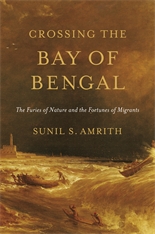This post was contributed by Dr Sunil S. Amrith a Reader in Birkbeck’s Department of History, Classics & Archaeology.
 My recent book, Crossing the Bay of Bengal: The Furies of Nature and the Fortunes of Migrants (Harvard University Press, 2013) tells the story of a neglected region that was once at the heart of global history and which, today, is pivotal to Asia’s economic and ecological future.
My recent book, Crossing the Bay of Bengal: The Furies of Nature and the Fortunes of Migrants (Harvard University Press, 2013) tells the story of a neglected region that was once at the heart of global history and which, today, is pivotal to Asia’s economic and ecological future.
For centuries the Bay of Bengal served as a maritime highway between India and China, and then as a battleground for European empires—the Portuguese were followed by the Dutch, the British, and the French—shaped by the monsoons and by human migration. In the nineteenth century the British Empire reconfigured the Bay in its quest for coffee, rice, and rubber. Millions of Indian migrants crossed the sea in one of the largest migrations in modern history, to work on the plantations of Malaysia and Sri Lanka, and on the docks and in the factories of Burma. Booming port cities like Singapore and Penang became the most culturally diverse societies of their time. By the 1930s, however, economic, political, and environmental pressures began to erode the Bay’s centuries-old patterns of interconnection, and these were broken by the Second World War.
The Bay fragmented as a coherent region in the second half of the twentieth century: it was carved up by the boundaries of nation-states; its histories were parceled out into separate national compartments. The postwar organization of academic knowledge drew a sharp distinction between the study of “South Asia” and “Southeast Asia.” But the recent resurgence of inter-Asian economic connections has seen the reinvigoration of the Bay of Bengal as a regional arena; and the force of the region’s environmental challenges calls our attention to the interdependence of its people.
Oceans of History
Historians have long been fascinated by seas and oceans, going back to the classic work of Fernand Braudel on the Mediterannean, the long tradition of scholarship on the trading links of Indian Ocean, and the thriving field of Atlantic history. Bodies of water can connect where land divides; putting the sea at the heart of our histories tends to emphasize mobility and interaction across the dividing lines of national or imperial borders. So often, the port cities of an ocean’s littorals are more closely connected to one another than to their own rural hinterlands.
By foregrounding the region of the Bay of Bengal—linked by journeys, stories, and cultural traffic, and of course by the power of empires—we can see beyond the borders of today’s nation-states, beyond the borders imposed by imperial map-makers and immigration officials, to a more fluid, more uncertain world. But Crossing the Bay of Bengal shows that these connections were often coerced, often violent. Many experienced the fragmentation of the region in the twentieth century as a liberation, while at the same time, many minorities and migrant groups found themselves stranded, excluded and out of place in the new nation-states of the region.
The research for this book took me all the way around the Bay of Bengal’s rim, from South India to Singapore, by way of Burma (Myanmar) and Malaysia, in a series of journeys made possible by the generous support of the British Academy and—in the last stages of the research for the book—a Starting Grant from the European Research Council.
One of the key aims in my research was to tell the stories of those whose lives had been shaped by migration across the Bay, but who left little written trace of their experiences—the rubber tappers and dockworkers, the sailors and rickshaw pullers, whose labour made the Bay one of the most economically vibrant regions of the world in the early twentieth century. Finding an echo of their voices required a flexibility of approach, and a wide range of sources: my research took me to the archives of Singapore’s coroner’s courts, where the stories of very ordinary migrants emerged in testimony when things had gone horribly wrong; it took me to state archives in India, Malaysia, Singapore, and Burma, and—closer to Bloomsbury—to the invaluable collections of the India Office Records at the British Library. Oral history was essential to the research: over many years, conversations with elderly people in Malaysia and India about their memories of migration, their family histories, and their experiences of labour, helped to cast archival material in a different light.
The Past in the Present
Two key forces have shaped the Bay of Bengal’s history, and they will be central to its future. The first is environmental. From the earliest times, the pattern of regularly-reversing monsoons made possible the Bay of Bengal’s trading routes: they were a source of life, and also of periodic disaster. In the nineteenth century, technological innovations including steam power promised to conquer the monsoons; but the monsoons asserted their enduring power over life and death in the great droughts that brought famine to the region in the 1870s and 1890s. Mass migration around the Bay of Bengal brought new sorts of environmental change to the Bay’s coasts, and made the region more interdependent.
Today, the Bay of Bengal is a region at the forefront of Asia’s experience of climate change. The monsoons are less predictable than they were. Sea level rise threatens the Bay’s densely-populated coasts, home to more than half a billion people. While the scale and nature of these changes is unprecedented—and their causes are planetary in scale, rather than localized—history tells us that the Bay’s peoples have long coped with the furies of nature.
One way they have done so is through migration over long and short distance, for short periods or more permanently. Migration is not, and never has been, an automatic or predictable response to natural disaster or to slow-onset environmental change: only where other factors are in place—government policies, the availability of credit, the presence of family or social networks in the places of migration—has it emerged as a viable strategy for family survival.
Its long history of migration gives the Bay one of its most distinctive features—its astonishing cultural diversity, the mixture of peoples and languages that are evident to even a casual visitor. Migration around the bay is on the rise again, in a part of the world where mobility has not been exceptional but quite normal. The peoples of the bay are not strangers to one another. The triumph of narrow nationalism over more inclusive political visions need not be permanent. Notwithstanding conflicts over land and resources, the region’s past is animated by common spiritual traditions and expressions of solidarity across cultures. The bay’s history, as much as its ecology, spills across national frontiers.
For more information, you can read two op-eds I recently published in the New York Times. ‘The Bay of Bengal, in peril from climate change‘, published on 13 October 2013 and ‘Snapshots of Globalization’s First Wave‘, published on 10 January 2014.
Website: sunilamrith.wordpress.com
Twitter: @sunilamrith


 When I travelled to Cairo last April, one of the first things I did was to visit Tahrir Square, scene of some of the most evocative and stirring events of what came to be known as the Arab spring of 2011. Not much was happening, and the banners and flags I spied at the opposite corner turned out to be knock-off Manchester United merchandise. It’s not uncommon for visitors to be met with encounters of extraordinary serendipity (“You’re from Nottingham? My cousin is a student there!”) as an opening gambit in the tourist trade, and I was quickly identified as yet another politics junkie and deftly plied with implausible yet seductive tales of intrigue and pending drama to soften me up for the inevitable invitation to buy something or other. Much has happened in Egypt since, but it was a useful reminder that revolutions are rarely a matter of unstoppable momentum or constant mayhem, and that the politics we identify in them isn’t lofty and abstract but the stuff of everyday life and work. I was in town to interview journalists at the
When I travelled to Cairo last April, one of the first things I did was to visit Tahrir Square, scene of some of the most evocative and stirring events of what came to be known as the Arab spring of 2011. Not much was happening, and the banners and flags I spied at the opposite corner turned out to be knock-off Manchester United merchandise. It’s not uncommon for visitors to be met with encounters of extraordinary serendipity (“You’re from Nottingham? My cousin is a student there!”) as an opening gambit in the tourist trade, and I was quickly identified as yet another politics junkie and deftly plied with implausible yet seductive tales of intrigue and pending drama to soften me up for the inevitable invitation to buy something or other. Much has happened in Egypt since, but it was a useful reminder that revolutions are rarely a matter of unstoppable momentum or constant mayhem, and that the politics we identify in them isn’t lofty and abstract but the stuff of everyday life and work. I was in town to interview journalists at the